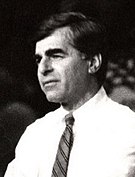United States presidential election in Vermont, 1988
|
|
||||||||||||||||||||||||||
|---|---|---|---|---|---|---|---|---|---|---|---|---|---|---|---|---|---|---|---|---|---|---|---|---|---|---|
|
||||||||||||||||||||||||||
|
||||||||||||||||||||||||||

County Results
Dukakis—50-60%
Dukakis—<50%
Bush—50-60%
Bush—60-70%
|
||||||||||||||||||||||||||
|
||||||||||||||||||||||||||
The 1988 United States presidential election in Vermont took place on November 8, 1988 as part of the 1988 United States presidential election, which was held throughout all 50 states and D.C. Voters chose 8 representatives, or electors to the Electoral College, who voted for President and Vice President.
Vermont voted for the Republican nominee, Vice President George H. W. Bush, over the Democratic nominee, Massachusetts Governor Michael Dukakis, by a margin of 3.52%. Bush took 51.10% of the vote to Dukakis's 47.58%.
While the Republicans held onto Vermont's 3 electoral votes once more, the closeness of the race represented a turning point in the state's political history. Vermont had once been one of the most Republican states in the country, historically having voted Republican more times than any other state, often by landslide margins. From 1856 to 1988, the state had gone Republican in every presidential election except for the 1964 Democratic landslide. Despite this history, the state was considered a swing state in 1988, and the Dukakis campaign targeted it in its electoral strategy. In this election, Vermont weighed in as about 2% more Democratic than the nation. With the exception of Lyndon Johnson in 1964, Dukakis's performance was the best of any Democratic presidential candidate in Vermont until Bill Clinton won the state in 1992.
...
Wikipedia


